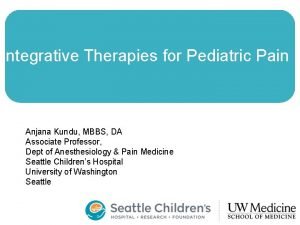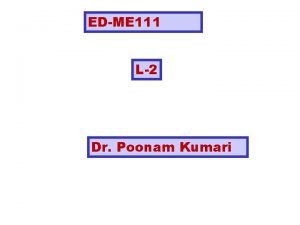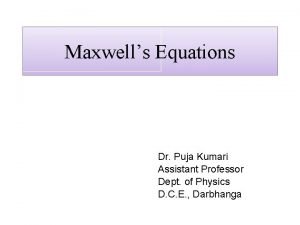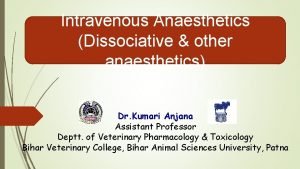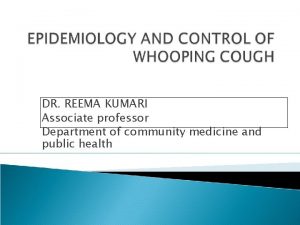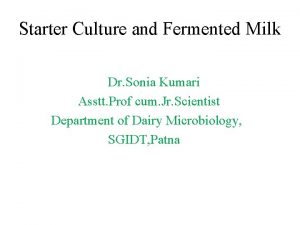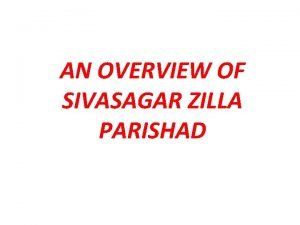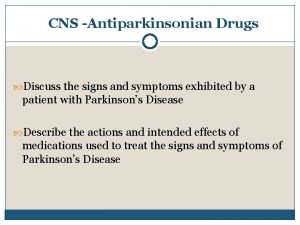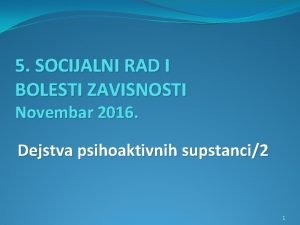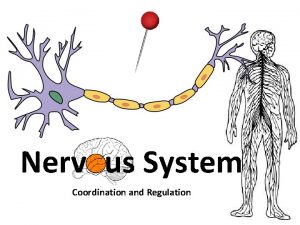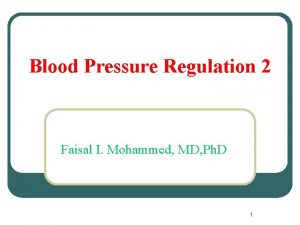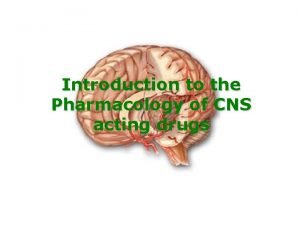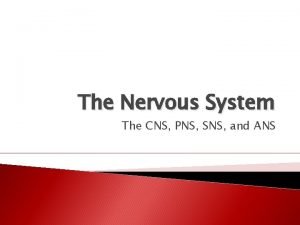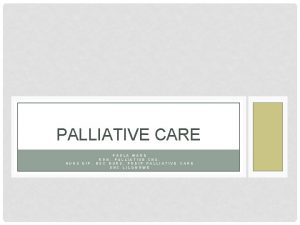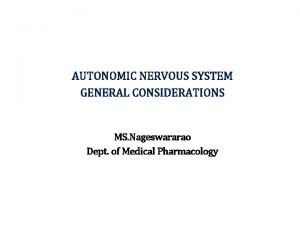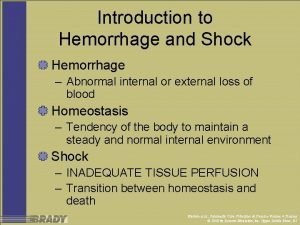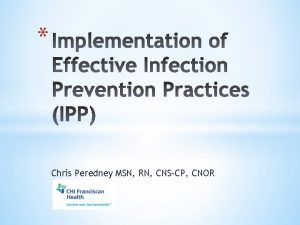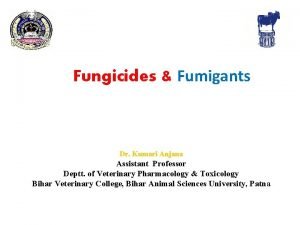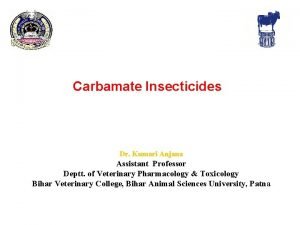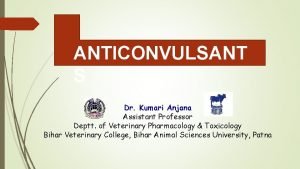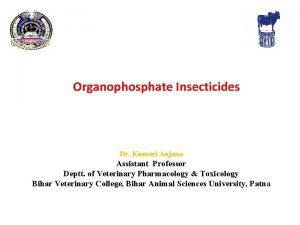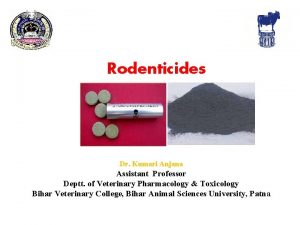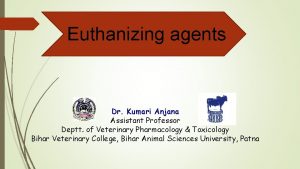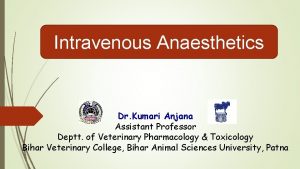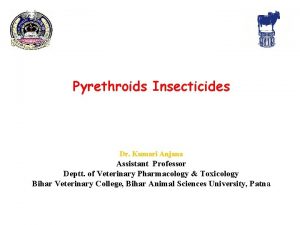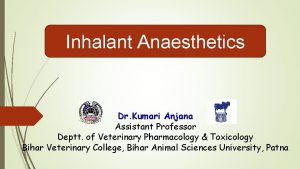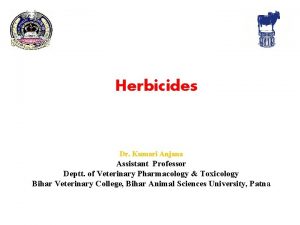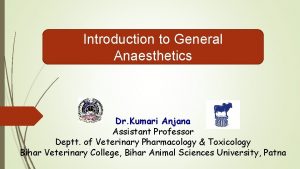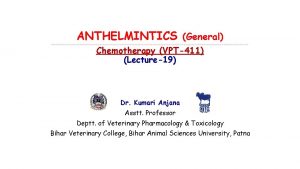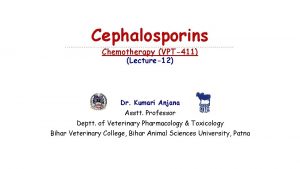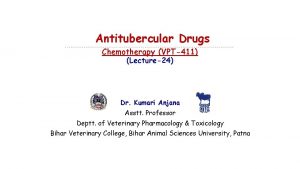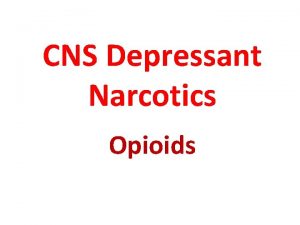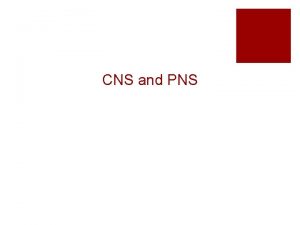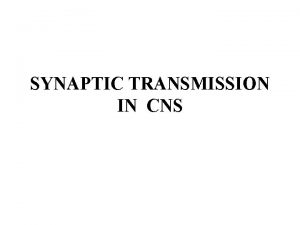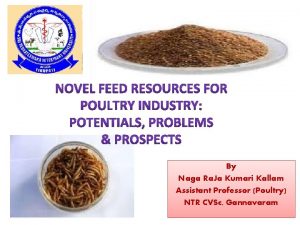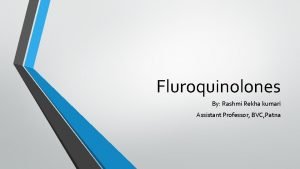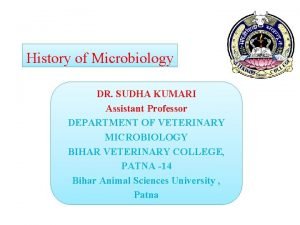TRANSMISSION IN CNS Dr Kumari Anjana Assistant Professor
























- Slides: 24

TRANSMISSION IN CNS Dr. Kumari Anjana Assistant Professor Deptt. of Veterinary Pharmacology & Toxicology Bihar Veterinary College, Bihar Animal Sciences University, Patna

TRANSMISSION IN CNS • • The function of the neurons is via signalling mediated by chemical mediators. 50 chemical Act presynaptically or postsynaptic ally. 3 categories Neurotransmitter Neuromodulator Neurotrophic factors Others- arachidonic acid metabolite.

Neurotransmitter • Chemical synthesized, stored and released by presynaptic nerve terminals, • Acts rapidly on the membrane of postsynaptic neuron, producing a change in conductance’s of excitatory or inhibitory responses in the postsynaptic neuron. • NT- released from presynaptic nerve terminal produce rapid excitatory or inhibitory response on the postsynaptic neuron. • • • dopamine, noradrenailine, acetylcholine, histamine, 5 -hydroxytryptamine, glutamic acid, aspartic acid, GABA, glycine, purines

Neuromodulator • A neuromodulator is a chemical that is formed de novo • released (not stored prior to release) by neurons as well as nonneuronal cells (astrocytes), • pre- or postsynaptic responses, • modulating presynaptic neurotransmitter release or post-synaptic excitability. neuropeptides, nitric oxide, eicosanoids, melatonin.

Neurotrophic factors • Synthesized and released by nonneuronal cells and activate tyrosinekinase-linked receptors which regulate gene expression and control nerve growth and phenotypic characters. cytokines, chemokines, growth factors.

Neurotransmitter • 2 categories. Amine NT • dopamine, • noradrenaline, • acetylcholine, • histamine, • 5 -hydroxytryptamine, Amino acid NT • glutamic acid, excitatory NT • aspartic acid, • GABA, inhibitory NT • glycine,

Noradrenaline • Noradrenaline- secreted by many neurons whose cell bodies are located in brain stem and hypothalamus. • Specially Nonadrenergic neuron cell bodies are in pons and medulla from where the noradrenergic pathways extend to many parts of brain and spinal cord including cortex, cerebellum, hypothalamus, hippocampus, reticular formation, thalamus etc. • Functions: Control of wakefulness and alertness of mood. Functional deficiency leads to depression. increase or decrease in central sympathetic tone and regulates the function of CVS, mainly the BP and cardiac function.

Dopamine • It is Important NT as well as precursor of NA in CNS. • Distribution in brain - non uniform. • Large proportion of Dopamine – corpus striatum, a part of extrapyramidal system and part of limbic system. • Dopaminergic neurons form three pathways Tuberohypophyseal system (Hypothalmus, median eminence and pituitary), mesolimbic and mesocortical pathways (midbrain, limbic system and frontal cortex) and mainly (about 80% of brain) in nigrostriatal pathway (substantia nigra, thalamus and corpus striatum). • Functions: Motor control, behavioral effects and endocrine function (control-prolactin secretion)

• Deficiency/degeneration of dopaminergic neurons causes Parkinson’s disease in man. • Schizophrenia- excess Dopamine activity • Receptors: D 1 and D 2 and D 4 (Cortex : arousal/mood) ; D 1 to D 5 (Striatum: motor control) D 1, D 2, D 3 and D 5 (Limbic system: emotion and stereotype behavior) and D 2 and D 3 (hypothalamus-anterior pituitary: prolactin secretion). • Agonists: Apomorphine and bromocriptine • Antagonists: All receptors: Chlorpromazine, haloperidol and clozapine D 2, D 3 and D 4: Spiperone and sulpiride

Acetylcholine • Distribution: All parts of brain (forebrain, cortex, midbrain and brainstem) • Functions: Arousal, learning, memory and motor control. • Degeneration of cholinergic neurons in hippocampus and basal forebrain results in Alzehimer’s disease in man (loss of intellectual ability/dementia).

Receptors: Muscarinic receptors (presynaptic G-protein coupled) M 1 in cortex and hippocampus, M 4 in cortex and striatum, M 5 in substantia nigra and M 2 throughout CNS inhibit Ach release. Nicotinic receptors (pre-and postsynaptic: inotropic).

5 -Hydroxytryptamine (serotonin) • 1% • Distribution: Pons, medulla, cortex, limbic system, hypothalamus and spinal cord. • Functions: Hallucinatory behaviors, feeding behavior, vomiting and control of mood/emotion, sleep/wakefulness and sensory pathways (including pain). • 5 -HT 1 D agonists (sumatriptan, ergotamine, methysergide) are used as anti migraine drugs.

Histamine • Smaller amount –minor NT • Distribution: Cell bodies in hypothalamus, with axons extend to all parts of brain. • Functions: Inhibitor of inhibitory transmitters, regulation of food and water intake. and mediation of central vomiting. thermoregulation. • Receptors: H 1 (postsynaptic excitatory), H 2 (postsynaptic inhibitory) and H 3 (presynaptic: auto inhibitory).

Glutamate/Aspartate • Found in very high concentration • Distribution: Glutamate in all parts of CNS (brain and spinal cord), but aspartate distribution is limited. • Functions: Fast excitatory transmission. • Receptors: NMDA (N-methyl-D-aspartate) postsynaptic slow EPSP, AMPA (Alpha-amino-3 -hydroxy-5 -methyl-4 isoxazolepropionate) postsynaptic fast EPSP and kainate (isolated from a seaweed) pre and postsynaptic fast receptors (ionotropic), metabotropic pre and postsynaptic receptors • Excessive stimulation-neuronal cell death-pathological condition, Epilepsy-abnormal expression.

GABA Is major inhibitory NT Distribution: uniformly, About one-third (30%)of all synapses in brain. Formed from glutamate through decarboxylation by glutamic acid decarboxylase. Functions: Inhibition in all area of CNS. Receptors: GABAA (postsynaptic) , ligand-gated chloride channel GABAB (pre and postsynaptic) which are and G-protein-coupled R • Agonists: GABA, diazepine (benzodiazepines), propofol and barbiturates and alphazolone on GABAA, GABA and baclofen on GABAB. • Drugs- potentiation of GABA at GABAA, • Block the chloride channel. • • •

Glycine • Distribution: Grey matter of brain stem and spinal cord • Functions: Inhibitory transmitter in spinal neurons. • Receptors: Glycine (postsynaptic) receptor like GABAA receptor a ligand-gated chloride channel. • Agonists: Glycine • Antagonists: Strychnine- blocking postsynaptic inhibitory response. Tetanus toxin -prevents its release from presynaptic terminals.

Purines • ATP and Adenosine (Neurotransmitters and/or neuromodulators) • Distribution: CNS (and peripherally also) in purinergic nerves. • Function: ATP as transmitter or modulator and adenosine as a widespread modulator. Adenosine • Adenosine may act as a protector of central neurons against damage caused due ischaemia or over stimulation (safety mechanism). • Adenosine causes CNS depression (drowsiness, motor incoordination, analgesia and anticonvulsant actions).

ATP is released during tissue injury, acts as one of the mediators of pain sensation (nociception). Released ATP is converted to ADP and adenosine. ADP causes platelet aggregation and dilatation of vascular smooth muscle, pre and postsynaptic depression (CNS). ATP • Receptors: A 1, A 2 and A 3 (G-protein-coupled) receptors for adenosine ATP acts on ligand-gated cation channel P 2 X excitatory receptors and G-protein-coupled P 2 Y inhibitory receptors • Agonists: ATP and adenosine on respective receptors. • Antagonists: Caffeine overcomes drowsiness (arousal reaction and alertness) is an antagonist of A 2 receptors.

Nitric Oxide (NO) • Nitric Oxide (NO): It is mainly a chemical mediator of peripheral tissues, but also found in some areas in CNS (cerebellum and hippocampus), • synthesized by a neuronal constitutive enzyme nitric oxide synthetase (n. NOS). • It also forms a potent toxic anion peroxynitrite (ONOO-) by reacting with superoxide free radical (O 2 -). • Causes brain ischaemia.

Tachykinins • Tachykinins: Include substance P (SP) and neurokinin A (NKA) and neurokinin B (NKB). • Widely distributed in CNS; • whereas, SP and NKA are in peripheral sensory nerves, facilitating nociception and mediating the local inflammatory responses.

Melatonin • It is the hormone of pineal gland formed from 5 -HT. • It is responsible in establishing circadian rhythms. • Its secretion is influenced by light intensity (high in night and low in day) • Regulated by the hypothalamus through retino- hypothalamic sympathetic (Nor. A) nerves. • Acts through melatonin receptors (G-protein-coupled) found in retina and hypothalamus. • The hormone has been claimed to the value to overcome ‘jet lag’ or in increasing the performance of night-shift worker. When given during day-time it induces sleep.

Lipid Mediators • Lipid Mediators: The formation of eicosanoid metabolites of arachidonic acid through cyclooxygenase and lipoxygenase pathways (prostaglandins, leukotrienes and HETEs) also occurs in CNS. • These may also serve as intra-neuronal messengers and also diffuse out of the nerve cell and produce effects on presynaptic nerve terminals or neighboring cells activating intracellular or extracellular receptors. • The functional integrity of the nervous system in regulating the physiological activity of an individual is the result of interplay of the central neurochemicals.

• Degeneration of central neurons and/or absence of central neurotransmitters results in neuro-degenerative disorders in human beings as listed below-- • Parkinson's disease- imbalance between dopamine and Ach in nigrogastrial tract. – disorders of movement in old. Tremor at rest. • Alzheimer's disease- loss of cholinergic neurons. --- loss of intellectual ability with age. • Schizophrenia- excess dopaminergic neuron activity—thought disorders, delusions. • Huntington's disease-- excess dopaminergic activity and loss of GABA inhibition----sudden jerky involuntary movements.

Thank You
 Anjana appachana
Anjana appachana Anjana kundu
Anjana kundu Promotion from associate professor to professor
Promotion from associate professor to professor Cuhk salary scale 2020
Cuhk salary scale 2020 Raj kumari amrit kaur coaching scheme
Raj kumari amrit kaur coaching scheme Dr poonam kumari
Dr poonam kumari Puja kumari xxx
Puja kumari xxx Sonia kumari dog
Sonia kumari dog Reema kumari
Reema kumari Proof of kumari kandam
Proof of kumari kandam Sonia kumari
Sonia kumari Zilla parishad
Zilla parishad Chaplair v kumari
Chaplair v kumari Cns
Cns Naas community national school
Naas community national school Depresori cns
Depresori cns Cns
Cns Depresori cns
Depresori cns Cns ischemic response
Cns ischemic response Classification of cholinergic drugs
Classification of cholinergic drugs Dermatome map
Dermatome map Cns ward
Cns ward Ans and cns difference
Ans and cns difference Cns ischemic response
Cns ischemic response Cnscp
Cnscp

